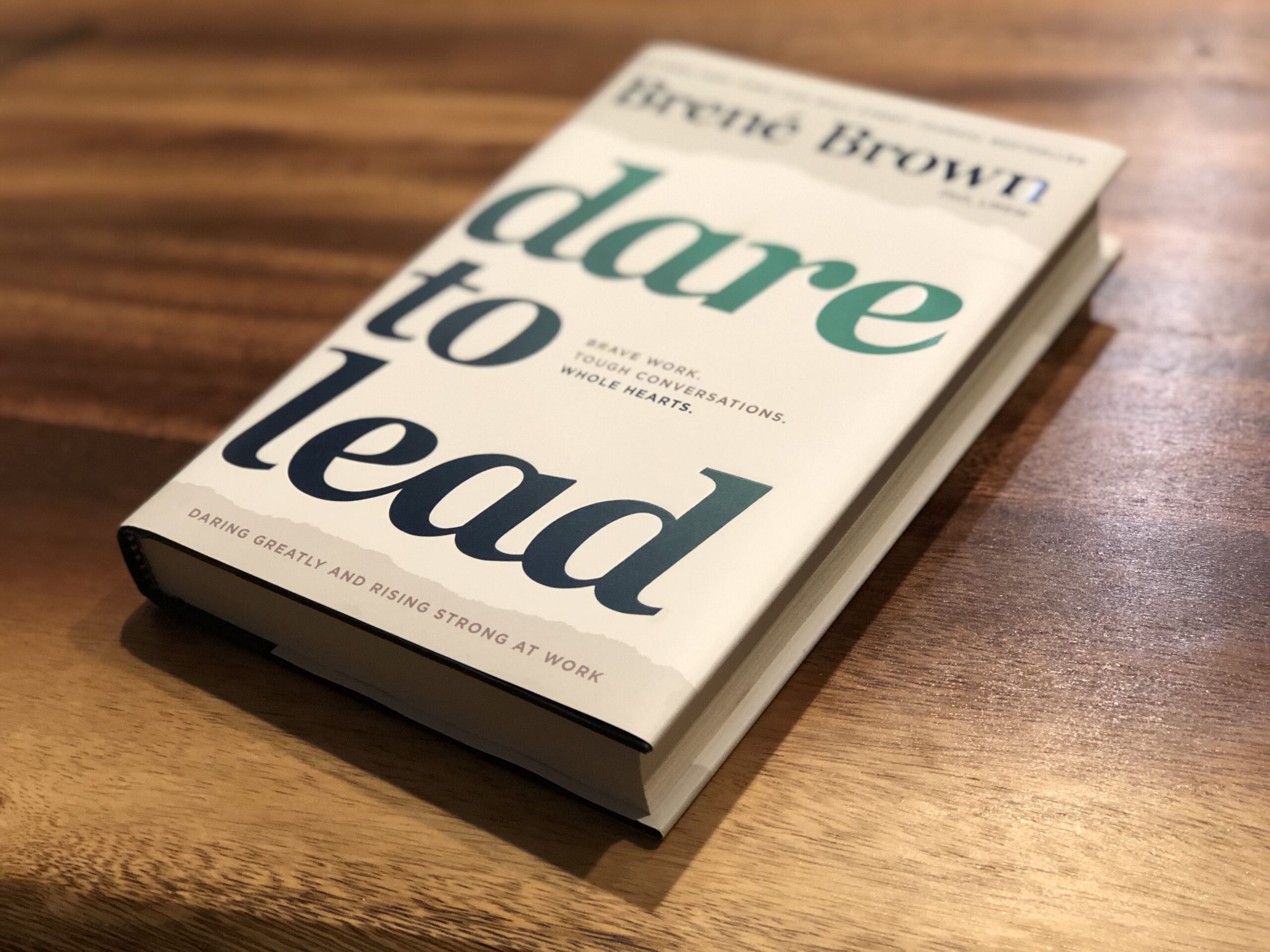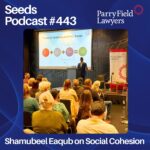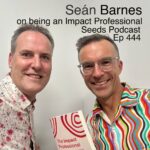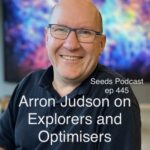The sub-title of this book is an indication of where it is headed: “Brave work. Tough conversations. Whole hearts.” I am starting to write this review before I’ve even opened the book because Brené Brown is one of those people I had already heard about before getting it. So a few words in advance about the context is important.
From the various things I’ve heard with her in the form of podcasts, videos and TedX talks it seems like she represents a new softening in the realm of business. I actually view this as one example of a real paradigm shift in our culture which I’ve been observing in the last decade. It encompasses other shifts and the introduction of terms like impact investing, social enterprise and balancing profit/purpose. Perhaps it coincides with my own shift, leaving behind a more corporate focused role as a lawyer at the end of 2015 after stops in London, Tokyo and Sydney in order to move to Christchurch. This has also resulted in a repositioning of my own legal career to look at more than just helping wealthy people accumulate more and a new focus on empowering people who want to effect positive change (through social enterprise / companies / charities). At any rate, I am grateful that there are voices like Brené who are raising deeper issues for us to think about than purely a focus on making more, buying more, and consuming more.
This is more than just a book review because it also sets out all my own personal reflections, learnings and key points I noticed as I read “Dare to Lead” over the Christmas break. So these are my own notes to reference back to in the coming year.
As an initial observation, I wonder if the people who need to read this book most will actually pick it up. I will be recommending it but those I know have read it are already quite in tune with the issues raised.
Of course, a world leading expert in vulnerability and shame risks coming across as aloof and above those other people who deal with such issues. Brené Brown’s skill is to counter this by immediately opening up about her own struggles so you can identify with her from the start. The opening sentences tell us she still gets nervous when speaking in public (yet she has one of the most watched Ted talks of all time). As an example of her storytelling style, she describes seeing what she thinks will be a tough audience and recognises someone that makes her realise they are all just people too: “I gasped and pulled the curtain closed. I know that guy. We got sober around the same time, and we used to go to the same AA meetings…”. This willingness to be open about her own weakness means the framing of what she has to say on vulnerability is positioned to be well received. She is one of us: A human with weakness and frailty.
The other thing about her style is that she writes in a very down to earth and engaging way. It’s very conversational and you feel like you are in a natural conversation rather than reading a text book – as an example: “…if you’re going to dare greatly, you’re going to get your ass kicked at some point. If you choose courage, you will absolutely know failures, disappointment, setback, even heartbreak. That’s why we call it courage. That’s why it’s so rare.”
So she counters the PhD by her name with this common sense approach and down to earth way of explaining her research. This is her 6th book so she is drawing on a lot of background material to write this and she even says to readers of the other books: “expect some familiar lessons with new context”. I haven’t read them but this does feel like a rehashing of the earlier books and she often quotes from them or cross refers to a story already having being given. I guess the plus side is that I didn’t feel like I really needed to get copies of those books because this one seems to be a statement of all that she has written about before: like a ‘best of’ album.
So, what is covered?
The book itself is divided into four parts – while the first is 166 pages (although that part has five sections) the rest average about 30 pages each. They are:
Part 1: Rumbling with vulnerability
Part 2: Living into our values
Part 3: Braving Trust
Part 4: Learning to Rise
Each of those parts also represent the skill sets which allow courage building to occur and grow and which she says can be taught, observed and measured.
So who is the book for? It’s about leadership but I personally think that means it would be helpful for everyone. Are we all leaders? Depends how you think of that label. There is one person who you are in charge of leading: yourself. If more of us took responsibility for leading ourselves well, the one person we have control over, then that would have a big impact in our world. She says: “I define a leader as anyone who takes responsibility for finding the potential in people and processes, and who has the courage to develop that potential.”
Part 1: Rumbling with Vulnerability
The key points in Part 1 relate to being willing to be vulnerable and can be summarised in this quote: “Our ability to be daring leaders will never be greater than our capacity for vulnerability. Once we start to build vulnerability skill sets, we can start to develop the other skill sets.”
The rest of this part talks about how to make connections with others and gives examples of learning to be open enough to be vulnerable. For example, she notes: “It turns out that trust is in fact earned in the smallest of moments. It is earned not through heroic deeds, or even highly visible actions, but through paying attention, listening, and gestures of genuine care and connection.”
It is hard to summarise an entire book and examples as well as the myths she dispels about vulnerability but she makes the point that, “Vulnerability for vulnerability’s sake is not, useful, or smart.” The examples she gives are based on her approach with what she calls “grounded research” which observes real behaviour and then draws out theories to test against other research that is already done.
One of the things I enjoyed about the book was that it brought in echoes from other people. For example, in this section on being vulnerable she notes the power of really listening to others and Stephen Covey’s advice, “Seek first to understand, then to be understood.”
Another statement is the subject of a chapter about clarity with others. She says: “Clear is kind. Unclear is unkind.” What this means is that if there has not been good communication between people and there are unclear expectations, then that lack of clarity will result in being unkind if you later hold people to a standard they did not even know about. In just the last few days since first reading this I have applied this in a few conversations and think it is something that I will be able to use in a number of different contexts.
It’s easy to think all this is opening up too much and being too “soft skills” focused without tangible and immediate monetary results for a business. To counter this, in this section I appreciated this observation about having a willingness to take on board these principles: “Leaders must either invest a reasonable amount of time attending to fears and feelings, or squander an unreasonable amount of time trying to manage ineffective and unproductive behaviour. What this means is we must find the courage to get curious and possibly surface emotions and emotional experiences that people can’t articulate or that might be happening outside their awareness.”
One of the key images that emerges from her work comes back to something Theodore Roosevelt wrote 100 years ago about being “in the arena”, and not listening to those critics who are just observing on the side-lines. This earlier short Seeds episode on creativity and vulnerability I mentioned that quote which she often uses as a starting point to reflect: https://seeds.libsyn.com/creativity
A few observations I thought were helpful from the rest of this section included:
- on criticism: “At the end of the day, at the end of the week, at the end of my life, I want to say I contributed more than I criticised.”
- on valuing skills I thought her observation that we often overlook our own strengths and take them for granted and forget that we ourselves are special – but once you understand your value then you can, “stop hustling for worthiness and lean into our gifts.”
- leaders give context for tasks by explaining purpose: “Rather than handing down black-and-white mandates stripped of story, they hold themselves responsible for adding texture and meaning to work and tying smaller tasks to the larger purpose.”
- on being busy: This is sure one that I think we all need to hear and remember as we consider who it is that we are even trying to impress “We have to let go of exhaustion, busyness, and productivity as status symbols and measures of self-worth. We are impressing no one.”
- on gratitude: It’s easy to forget to thank people and remember to be grateful but she observes that “Embodying and practising gratitude changes everything. Something as simple as starting or ending meetings with a gratitude check, when everyone shares one thing they’re grateful for, can build trust and connection, serve as container-building, and give your group permission to lean into joy.”
- on feelings: “The vast majority of people I’ve interviewed are not comfortable in the world of emotions and nowhere close to fluent in the language of feelings. Emotional literacy, in my opinion, is as critical as having language. When we can’t name and articulate what’s happening to us emotionally, we cannot move through it.”
- On empathy she writes a lot and observes that it is at the heart of connection so that you can really feel what others feel and make sure that we all know that we are not alone. I also really appreciated this quote as I find it hard to do: “The trickiest barrier to empathy? Take a look in the mirror. Being kind and extending the hypothesis of generosity to ourselves when we mess up is the first step. Resisting the urge to punish or shame ourselves when we make mistakes is true mastery.”
- On curiosity: I always appreciate observations from people about this because it has emerged as a key learning for me from doing seeds podcast as the most powerful tool to really understand someone else’s story: “Curiosity is an act of vulnerability and courage. Researchers are finding evidence that curiosity is correlated with creativity, intelligence, improved learning and memory, and problem solving. But curiosity is uncomfortable because it involves uncertainty and vulnerability.”
- As a parent I thought this was helpful, and a great reminder to be aware of what we praise: “The more grounded confidence parents have, the more likely they are to prepare their child for the path by teaching courage, praising effort, and modelling grit, versus trying to prepare a perfect path for their child by fixing, praising only results, and intervening.”
That’s a potpourri mix of the topics covered in the first section of the book. As a small comment I am not sure I gelled with the term “rumbling” with the key sensitive issues that she says needs to be talked about openly. I get the point, it is just I am not sure the phrase was the best one because to me it is a rough term, like wrestling that is aggressive – because sometimes dealing with those sensitive things will need to be dealt with gently not by “rumbling”.
Part 2: Living into our values
The next part shifts gears and moves from talking about being open to vulnerability, empathy and curiosity to living into our values. Here she suggests that you need to identify two core values which then are the foundation for all your activity and work. Perhaps it was reading this in that period between Christmas and New Year but I found if helpful to think in these terms when also considering goals for the next year. This quote summarises the essence of the focus on values:
“The daring leaders we interviewed were never empty handed in the arena. They always carried with them clarity of values. This clarity is an essential support, a North Star in times of darkness. Living into our values means we do more than profess our values, we practise them. We walk our talk – we are clear about what we believe and hold important, and we take care that our intentions, words, thoughts, and behaviours align with those beliefs.”
For me in this part I settled on 3 values which is one more than she suggests but I’ve always liked the power of three, so I chose:
1. Empowering positive change – for me that is both my legal work and connecting people who can then help each other (this is outworked through organising impact lunches and the upcoming impact unconference);
2. Courage – to stand up for what is right including defining points that make me unique like my beliefs, faith and actively prioritising my family over other pressures (having the courage to stand up for those things is a key value); and
3. Creativity – this takes many forms and I think infuses all I am attempting to do – without it things become drudgery, but I get energy from activities such as writing, Seeds podcast and finding solutions to problems.
As one extra thing, I also think that retaining a “lightness” in what I do will be important as I live the values out – it is important not to get too serious!! It’s one thing to articulate those, but the real challenge she says is to lean in and live into them. The key is to identify the early warning signs that you are not living consistently with your values. This could take the form of not getting enough sleep, not eating well, not exercising or forgetting to take time out. I’m sure we can all identify certain signs that are indicators for us: taking on too much, confusing whose views actually matter, not getting to the gym, not feeling creativity has any outlet, feeling resentment about doing something. Those are all big warning signs and factors for me. Writing this review is an example of living into my values because it took time to read the book, which involved carving out space and learning, being challenged and then using creativity to write this and share to help others – so it is an example of living my values.
She comments on the difficulty of actually doing all this: “I used to believe that we would always know were in our values when the decision comes easily, but I’ve learned as a leader that it’s actually the opposite. I know I’m in my values when a decision is somewhere between tough and really tough.”
I shared that I was writing this review on social media for Seeds and my friend Fiona Deehan from Cara Consulting commented on this aspect:
“Have read twice (and got some new learnings second time round) … probably the most powerful thing for myself has been the values work…narrowing it down to 2 and then defining behaviours that operationalise them and recognising when I’m not aligning with them. A recent reflection on 2019 and learnings has revealed that I needed to change one of the ones I’d originally chosen. These values act as a compass, a tangible navigational tool, that I’m trying to integrate into my life as much as possible.”
The final thoughts in this part of the book discussed how to give and receive feedback as well as the value of sharing what motivated us with coworkers. Ultimately the focus there is helping others live into the values they hold closest which is the reason that is discussed here.
Part three: Braving trust
This is a short part and encourages people to maintain and build trust between people in organisations by using the acronym BRAVING, which stands for:
- Boundaries
- Reliability
- Accountability
- Vault (keeping things confidential)
- Integrity
- Nonjudgment
- Generosity
There is a lot written about each of these but I thought one quote gave a good example of the type of issue being raised: “When it comes to people who do not habitually ask for help, the leaders we polled explained that they would not delegate important work to them because the leaders did not trust that they would raise their hands and ask for help. Mind. Blown. When we refuse to ask for help, we will find that we keep getting the same projects that leaders know we can do. We will not be given anything that might stretch our capacity or skill set because they don’t believe we will ask for help if we find ourselves in over our heads.”
The message echoes what the book started with on trust: “Trust is the stacking of small moments over time, something that cannot be summoned with a command.”
Part 4: Learning to Rise
Perhaps I was a bit tired but by the time I got to this final fourth part it felt like the book had started to turn into a lot of (great) lists for ways to improve in different areas. It felt like some of the content might be better as standalone books and perhaps that’s how some of it started because this really is a “best of” drawing on a lot from earlier books she has done. Having said that, I was ready to close it out well and in this final part we are left with some challenges. The theme here is “Learning to rise”, and she explains: “If we don’t have the skills to get back up, we may not risk falling.” She goes on to make the point that if we are brave then we will fail so we need to have the ability to get back up – to rise.
In order to deal with the hard times she suggests you need to grapple with them and to do that she suggests articulating “The story I am making up is …” and then you express what you are feeling. By doing that you can go deeper to understand what you are really feeling and why you are responding the way you are.
Ultimately the point is this; “When we have the courage to walk into our story and own it, we get to write the ending. And when we don’t own our stories of failure, setbacks, and hurt – they own us.”
One of the final parts of the book that I liked was this quote: “We fail the minute we let someone else define success for us. I spent too many years taking on projects and even positions, just to prove I could do it. I was driven by a definition of success that didn’t reflect who I am, what I want, or what brings me joy.”
She then urges us to think about what actually brings us joy, as it will be different for each of us. Sometimes it’s easy to get distracted and work longer in order to earn times of joy when in fact it was there all along and we missed what we were actually seeking.
Conclusion
I think this book was able to set out clearly some principles which have been at the back of my mind but I’ve never articulated. And perhaps that is what the best books do – show us something about ourselves that’s been there all along. I have a feeling that the people who most need to read this book might not be in the mindset or be willing to pick it up, but I’m glad that I did and I encourage you to read it too.
– – –
As a final point, Kaila Colbin, who founded Boma NZ has been trained to be an instructor (by Brené) and she has run several courses across New Zealand. If this review has piqued your interest you should check that out too as several people I know have done it and recommended it (Camia, Fiona and Erica). Here is the link: https://nz.boma.global/dare-to-lead





